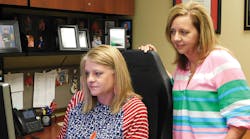Editor’s note: This is the second part in a series on women working in the trucking and how fleets are welcoming them to the industry. Read Part 1.
One reason fleets are seeking out women drivers is that they tend to be safer.
Jeremy Reymer, CEO of DriverReach, an applicant tracking system and member of the American Transportation Research Institute (ATRI) Research Advisory Committee, said male truckers have an 88% higher risk of receiving a reckless driving conviction than their female counterparts.
Males also have a 78% higher risk of receiving a seat belt violation, a 73% higher risk of receiving a traffic signal conviction, and a 70% higher risk of receiving a speeding conviction.
Williams said women tend to log more total miles and stay with their carriers longer.
“Anecdotal information says they’re better at paperwork and build stronger relationships,” she said.
Jodi Godfrey, a research associate with the Mineta Transportation Institute (MTI), noted the number of women in managerial positions is also growing, and more women are tackling safety and highly technical positions.
“Women tend to be more attracted to communal goal positions and roles where they’re helping society,” she said. “I see more women coming into higher education for civil engineering. In general, the trend for educational attainment has shifted where women account for a higher share of people with degrees.”
Adding more female drivers will translate into more women in leadership positions within the industry, said Kristi Williams, chief financial officer of Lone Star Transportation. “Some of the key people in operations started as drivers,” she explained. “Our CEO started as a driver, and a lot of our key managers have been drivers.”
Importance of mentoring
Williams, who joined Lone Star in 1997 as a staff accountant, said her mentor, former controller and current vice-chairman Don Murray, aided in her success with the company. “He gave me a big-picture view of my role, and it really helped to shape who I became,” she said.
Today, Williams works to mentor those on her team, including the existing controller, Tamela Yarbrough, who has been with the company for 12 years.
As a driver, Treana Moniz sees herself as a mentor.
“Not only do I drive for Bison, but I am also on the driver advisory board, and I go to recruiting events. I represent Bison in the truck driving championships and convoy for the Special Olympics,” Moniz said.
Moniz just signed on at Bison to be a driver mentor and said “it will be awesome to help and encourage” drivers as they begin their careers. She is also a Road Knight for the Ontario Trucking Association and serves as an Image Team member for Women In Trucking.
Driver Ingrid Brown, for whom a truck stop in Oklahoma City is named after, also serves on the Women In Trucking Image Team and is part of a safety campaign with the Federal Motor Carrier Safety Administration. “I’m on billboards, public radio, XM Sirius Radio, and I have my name on a TA/Petro,” she said. “I like to share my experience.”
Role models are powerful and are one of the best ways to get women in jobs that have been male-dominated, such as driving, said Josephine Berisha, senior vice president of compensation and benefits for XPO Logistics. “There’s no better role model at XPO than Ina Daly, an LTL driver. She’s been with us for almost 35 years, and she’s broken down barriers as the first woman to win the National Truck Driving Championship,” she said.
This is the second part in a series on women working in the trucking and how fleets are welcoming them to the industry. Read Part 1. Next, we'll look at how fleets are attracting more women.



